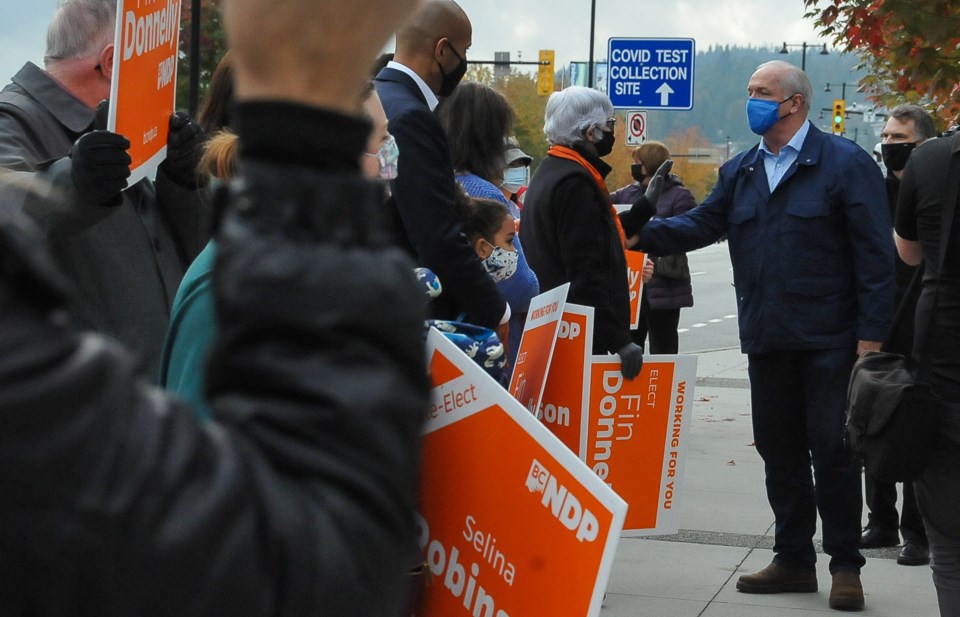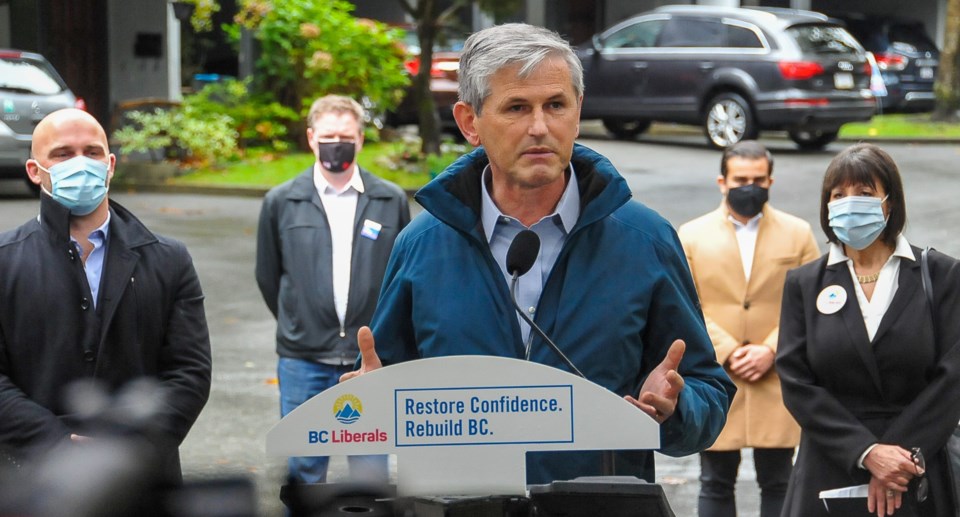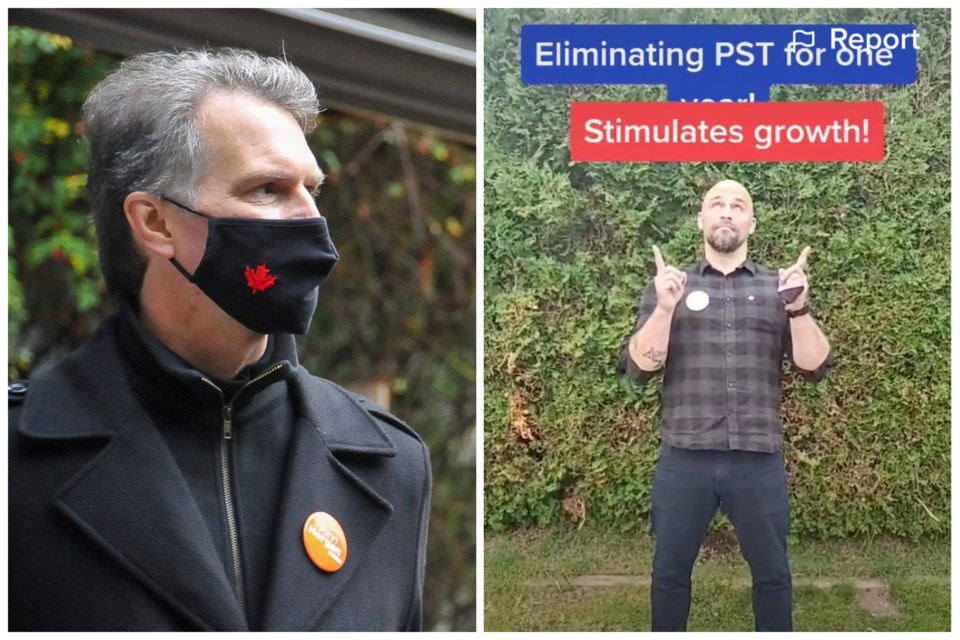You might not have realized it but you were the target in one of the strangest election campaigns in modern history.
In a normal election year, candidates would be hitting the pavement, systematically knocking on doors to win over voters one-on-one. But this is hardly a normal year, and between the pandemic and new restrictions on union and corporate donations, how the NDP, Liberals and Greens are getting out the vote has diverged as much as each party’s vision for B.C.'s future.
In the ridings of Coquitlam-Burke Mountain — expected to be one of the tightest in the province — BC Liberal candidate Joan Isaacs has skipped at least one environmental debate to knock on doors and is devoting hours out of every day to meet voters at their doorstep in an effort to win them over.
“Our door-knocking continues to be effective,” Isaacs told the Tri-City News, adding her party has implemented safety protocols like wearing face masks, sanitizing and talking to voters from a distance.
That’s in stark contrast to BC NDP candidate Fin Donnelly’s campaign, which is looking to unseat the one-time MLA after the riding flipped to the BC Liberals by an 87-vote margin in 2017. Instead of going door-to-door, campaign manager Matt Djonlic said the team focused on big digital ad buys on social media platforms like Facebook, YouTube and Instagram.
Djonlic wouldn’t disclose how much the party has spent on digital advertising, and centralized BC NDP spending on Facebook obscures the exact amount the party has committed to the Donnelly campaign. Donnelly's paid Facebook messaging has largely hung on centralized party messaging around plans for affordable housing, investment in health care and black and white choices such as “Helping the rich get richer, or helping you get through the pandemic?”
"The pandemic has impacted not only campaign spending, but how we campaign in general,” said Donnelly in a written statement to the Tri-City News.
Donnelly added that he has connected to voters through texts, phone calls and zoom meetings, while his team has dropped off signs, leaflets and together visited people at SkyTrain stations, small businesses and parks.

The Isaacs campaign confirmed it has spent “in the ballpark” of $2,100 in the last week alone on Facebook advertising (that number obscures certain supplementary spends that can ‘boost’ posts).
Much of Isaacs messaging has focused on scripted videos focusing on child care, small business and her track record as MLA. The ads are distributed to targeted audiences, including men and women of all ages, some of which have appeared on up to 70,000 screens, accord to the Facebook Ad Library.
Despite the push to reach voters online, every party is working with less money this year to convince voters. Campaign budgets for the NDP and Liberals have been slashed this year from roughly $15 million in 2017 down to under $1.5 million in the lead up to this year's election cycle, according to an analysis by CBC News.
“With a smaller budget, we have had to be creative with how we spend — including utilizing Facebook advertising in order to reach more voters that we may never otherwise have been able to contact,” said Isaacs.
Green candidate Adam Bremner-Akins, meanwhile, said he has avoided going door-to-door and just recently put in a $300 request for a digital ad buy.
“I don’t think it’s safe enough to do it,” he said of door-knocking. “I don’t want to risk any of my volunteers getting sick. I don’t want to risk getting sick — my grandpa lives with me — and I don’t want to get residents sick.”
PUSH ONLINE GETS CREATIVE
It’s not just door-knocking — or its absence — that’s defined each campaign. In one of the most unique elections in modern history, candidates are looking to get creative in a push to reach voters during the pandemic — and Facebook, Instagram and TikTok are seen as key tools.
“There’s definitely less money around, that’s absolutely for sure,” said Fritz Radandt, campaign manager for Liberal James Robertson in the neighbouring riding of Port Moody-Coquitlam. “We’re sort of in the first cycle of this and we’re starting to see the impact. It’s tough because it’s shrunk the donor base.”
In practical ways, COVID-19 has helped with campaign budgets, by eliminating the need for costly campaign events — no more large rallies and election night parties, or large offices to handle day-to-day activities.
Leaders whisk into the riding, the visit photographed, shot on video and posted to Facebook, while most of the press ask questions by phone.

The NDP spokesperson for Rick Glumac, who is looking to defend his Port Moody-Coquitlam seat, wouldn’t share campaign details or information about how shrunken budgets or COVID-19 have affected the party’s election strategy in the riding, but said the campaign has “changed a lot” with the candidate meeting voters via Zoom, through emails and text.
However, it’s clear new strategies have been crafted to deal with COVID-19 and scarce resources.
The political ground-game in the hotly-contested riding of Port Moody-Coquitlam is centred around social media, at least for the Liberals, where the young father and former veteran James Robertson has 43 Facebook ads, compared to Glumac’s 25.
In the case of one ad, Facebook analytics show one million people were reached. It features Robertson wearing a fishing vest and talking about his love for fishing and the importance of salmon and the environment. Also posted to Instagram and TikTok, the ad reached an audience made up of 75% men and 25% women, according to Facebook’s Ad Library.
Another ad showed Robertson door knocking and had an audience reach of between 10,000 and 50,000, according to Facebook, and 30% of viewers were men between the ages of 18 and 34. Other ads showed a wide demographic and featured the party’s promise to eliminate the PST in one year and raise it to 3% in the second year if the Liberals are elected.
“That’s our number one advertising spend now, just posting and boosting,” said Radandt. “You get really good targeting. It tends to be fairly effective.”
In contrast, Glumac ads feature testimonials from local residents, with many of them reaching a slightly older, often female audience. For example, one ad, featuring a testimonial to Glumac by Port Moody resident Maria Wahl reached an audience of 46% women over the age of 45.
While exact social media spending figures aren’t known, details contained on the Facebook Ad Library show the NDP has spent $306 since June of 2019 for Glumac compared to a Liberal spend of $3,179 for Robertson.
Robertson’s comfort with TikTok, a social media app popular with youth, helped garner support from Liberal HQ, which expanded the reach of the ad, Radandt said.
“One of the things social media allows with the video is you can show the personality: [Robertson] is a big guy and he’s very expressive. he’s a great communicator.”
Meanwhile, Port Moody-Coquitlam Green Party candidate John Latimer has been meeting with voters face to face, either on the door step, pop-up events or at a campaign office.
Meeting with people is seen as important, Radandt said, because voter support needs to be identified to ensure people who intend to vote get to the polls.
However, he noted that with so many people casting ballots in advance or by mail, the proportion of voters going to the polls on Election Day will be smaller, and likely the outcome won’t even be known for weeks if numbers are close.
“Even without COVID, it was changing with these new election laws,” said Radandt. “We’ll just have to see… I think going forward, politics will be done differently, [but] there will be different ways to get the message out.”
With the countdown to the Oct. 24 election underway, it remains to be seen how the different campaigns play out in votes for the battleground ridings of Coquitlam-Burke Mountain and Port Moody-Coquitlam.



